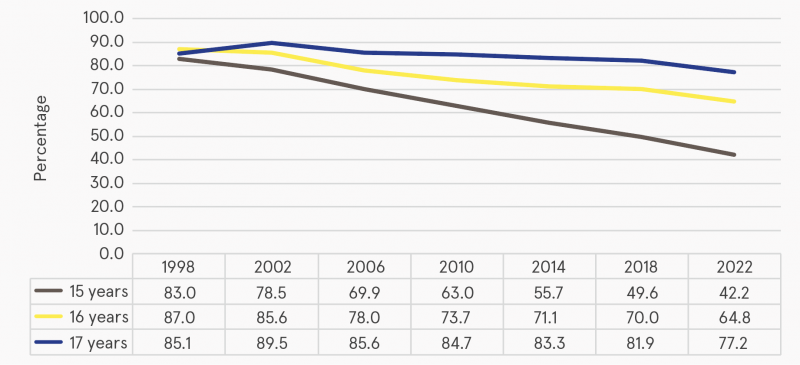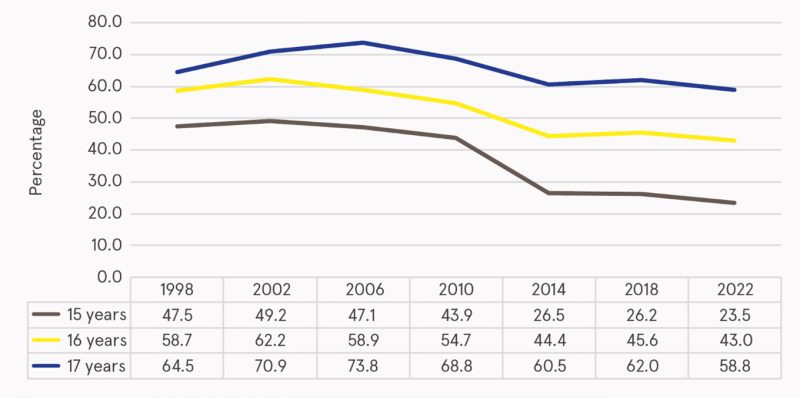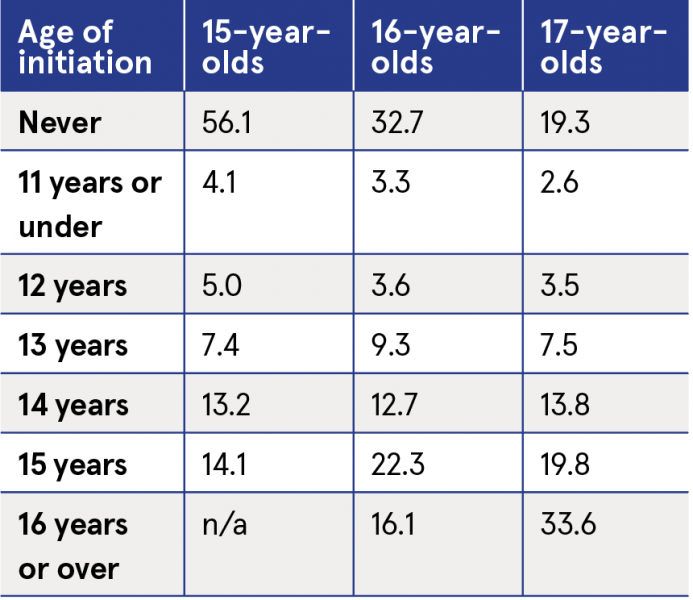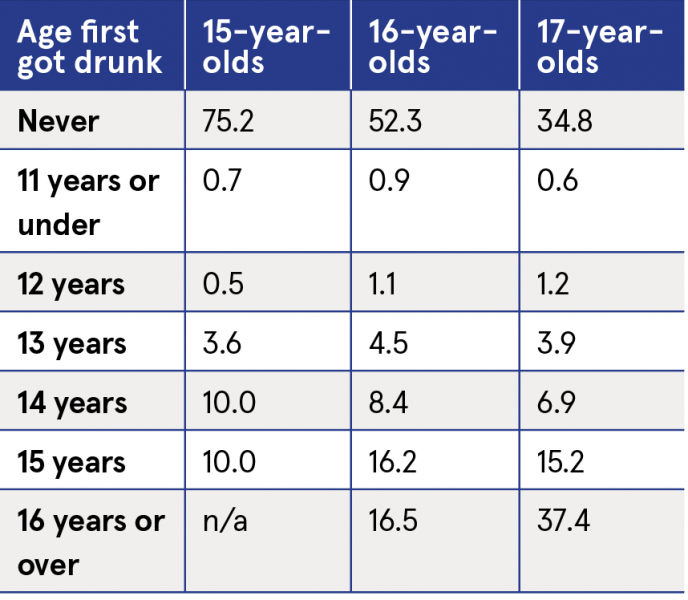Doyle, Anne  ORCID: https://orcid.org/0000-0002-2776-3476
(2025)
Adolescent alcohol use continues to decline: findings from the Health Behaviour in School-aged Children survey 2022.
Drugnet Ireland,
Issue 90, Winter 2025,
pp. 23-26.
ORCID: https://orcid.org/0000-0002-2776-3476
(2025)
Adolescent alcohol use continues to decline: findings from the Health Behaviour in School-aged Children survey 2022.
Drugnet Ireland,
Issue 90, Winter 2025,
pp. 23-26.
| Preview | Title | Contact |
|---|---|---|
|
PDF (Drugnet Ireland issue 90)
1MB |
Background
Much of Western Europe, North America and Australasia have seen a decline in alcohol use among young people.1-2 This is welcome indeed given that alcohol use is ranked as the second-highest contributor to disability-adjusted life years (DALYs) among adolescents and young adults aged 10–24 years globally.3 Alcohol contributes to all of the leading causes of death for young people, including suicide, road traffic collisions, poisoning and assaults, while long-term use is linked to multiple types of cancer, cardiovascular disease and liver disease.4,5 The Public Health (Alcohol) Act 2018 aims to reduce population-level alcohol use, but specifically seeks to prevent or delay youth drinking.6 In order to determine if this phenomenon extends to Irish youths, data from the Health Behaviour in School-aged Children (HBSC) survey were examined.7
Data source
The HBSC survey is carried out in 51 countries across the world and examines a wide range of issues, including substance use, bullying, mental health and food and dietary behaviour. The HBSC survey was first conducted in Ireland in 1998 and has been repeated every 4 years since. The 2022 survey included a representative sample of 9,071 children drawn from third class in primary school through to fifth year in post-primary school.
The data presented here represent the responses of the schoolchildren aged 15–17 years who completed the survey, specifically the questions about the prevalence and patterns of alcohol use. The findings from the 2022 survey were published in 2024 and are supplemented here with additional unpublished tables obtained from the HBSC team.7 Comparisons are made here between the 2022 survey and previous HBSC surveys to assess if the decline in adolescent alcohol use continues, as was previously reported.8
Alcohol use among schoolchildren
Lifetime alcohol use – trends over time
Alcohol use was determined by asking study participants if they had ever drunk alcohol in their lifetime (more than sips and tastes). Figure 1 illustrates a steady decline in alcohol use among schoolchildren aged 15–17 years. This is especially apparent among the younger teenagers; for example, in the 1998 HBSC survey, 83.0% of 15-year-olds had started to drink alcohol, whereas in 2022, 42.2% of 15-year-olds had started to drink alcohol. The decline is less pronounced among 17-year-olds, declining from 85.1% in 1998 to 77.2% in 2022.
Hazardous drinking – trends over time
Hazardous drinking among adolescents was gauged by asking respondents if they had ever been drunk in their lifetime and Figure 2 shows the percentage of schoolchildren who indicated that they had. Again, the decline is evident across each of the HBSC surveys and markedly so among 15-year-olds. In 1998, almost one-half of 15-year-olds reported being drunk in their lifetime, and this had declined to 23.5% of 15-year-olds in 2022.

Figure 1: Percentage of schoolchildren reporting alcohol use, by age

Figure 2: Percentage of schoolchildren reporting having ever been drunk, by age
Age of alcohol initiation
The survey also asks the schoolchildren to indicate what age they were when they first drank alcohol (more than a small amount). Table 1 indicates that in the 2022 survey, of those who had initiated alcohol use, one-third of 17-year-olds reported that they first drank alcohol at the age of 16 years or over (33.6%).
Table 1: Percentage of schoolchildren who reported age of alcohol initiation, by age

Of the schoolchildren who reported that they had been drunk, they were further asked to indicate at what age they first got drunk. Table 2 illustrates that schoolchildren were typically most likely to report first being drunk at age 15–16 years.
Table 2: Percentage of schoolchildren who reported age of drunkenness initiation, by age

Discussion
Alcohol use among schoolchildren continues to decline in Ireland. This may be due to the effect of policies introduced, such as the Public Health (Alcohol) Act 2018, or a growing awareness among parents and their adolescents alike of the dangers associated with alcohol and a decline in parental provision of alcohol. The HBSC survey is a valuable source of data to monitor adolescent alcohol use in Ireland and can be used to assess the impact of the legislation.
1 Holmes J, Fairbrother H, Livingston M, et al. (2022) Youth drinking in decline: what are the implications for public health, public policy and public debate? Int J Drug Policy, 102: 103606. Available from:
https://www.drugsandalcohol.ie/35635/
2 Oldham M, Callinan S, Whitaker V, et al. (2020) The decline in youth drinking in England—is everyone drinking less? A quantile regression analysis. Addiction, 115: 230–238.
3 Murray CJL, Aravkin AY, Zheng P, et al. (2020) Global burden of 87 risk factors in 204 countries and territories, 1990–2019: a systematic analysis for the Global Burden of Disease Study 2019. Lancet, 396: 1223–1249. Available from: https://doi.org/10.1016/s0140-6736(20)30752-2
4 Griswold MG, Fullman N, Hawley C, et al. (2018) Alcohol use and burden for 195 countries and territories, 1990–2016: a systematic analysis for the Global Burden of Disease Study 2016. Lancet , 392: 1015–1035. Available from: https://www.drugsandalcohol.ie/29555/
5 Rehm J, Gmel Sr GE, Gmel G, et al. (2017) The relationship between different dimensions of alcohol use and the burden of disease—an update. Addiction, 112: 968–1001.
6 Office of the Attorney General (2018) Public Health (Alcohol) Act 2018. Dublin: Irish Statute. Availablefrom:
https://www.drugsandalcohol.ie/33698/
7 Gavin A, Kolto A, Lunney L, et al. (2024) The Irish Health Behaviour in School-aged Children (HBSC) Study 2022. Galway: Department of Health and University of Galway. Available from:
https://www.drugsandalcohol.ie/40947/
8 Doyle A, Sunday S, Galvin B, et al. (2022) Alcohol and other drug use among children and young people in Ireland: prevalence, risk and protective factors, consequences, responses, and policies. Dublin: Health Research Board. Available from: https://www.drugsandalcohol.ie/36112/
A Substance use and dependence > Prevalence > Substance use behaviour > Alcohol consumption
A Substance use and dependence > Personal history of substance use (pathway) > Initiation
B Substances > Alcohol
T Demographic characteristics > Adolescent / youth (teenager / young person)
T Demographic characteristics > Student (secondary level)
VA Geographic area > Europe > Ireland
Repository Staff Only: item control page